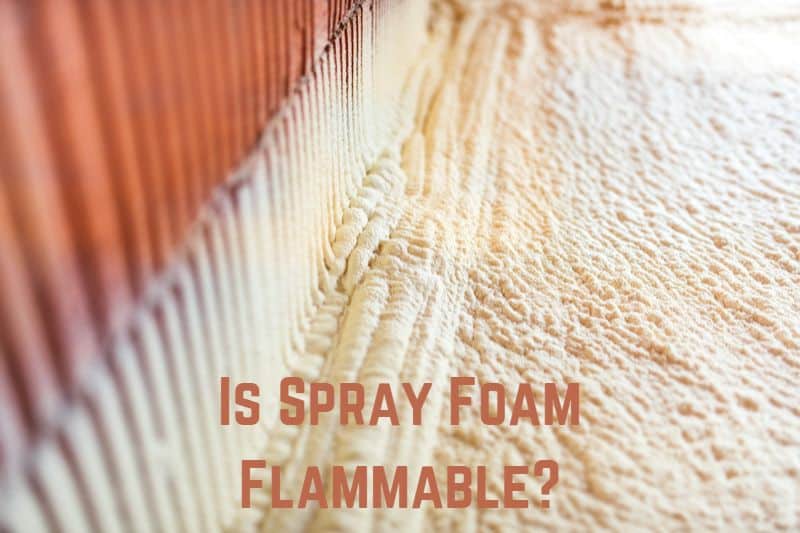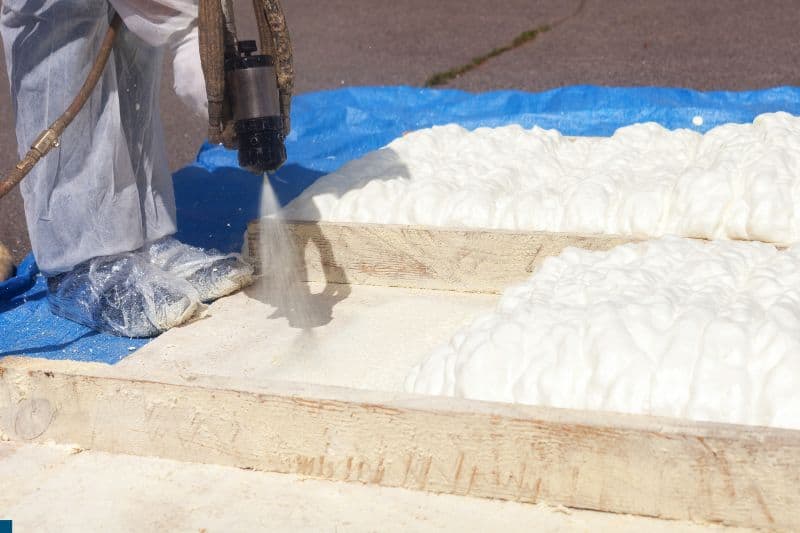Is Spray Foam Insulation Flammable?

A lot of thought must go into your home’s insulation selection. There are different insulation types, and making a choice can be difficult. One of the approaches that most people recommend is spray foam insulation. However, due to its flammability, other people are not so confident about it. So, is spray foam insulation flammable?
The first question we will answer in this article is that one. We also inform you about spray foam’s flammability, flammability level, toxicity, and whether it catches fire. Finally, we explain the dangers of burning spray foam and other insulation alternatives.
Read: Is Spray Foam Waterproof?
Is Spray Foam Flammable?
Spray foam is flammable. It will ignite and burn if there is a heat source since it’s a type of plastic. However, fire retardants are added to spray foam insulations to slow down and prevent a fire explosion. Spray foam insulation thereby slows down the rate at which fire burns, allowing you ample time to flee or get fire-fighting equipment.
Chemically treated fire retardants benefit from self-extinguishing and slowing ignition and burning. Spray foam insulation becomes a fire accelerant when there is no fire retardant. The majority of spray foam insulation products are created from expanded polystyrene and polyurethane foams, both of which are derived from petroleum.
Spray foam insulation can last for an hour without the flame spreading. It has a class 1 rating, one of the safest. The insulation prevents a fire from spreading or prevents one from starting. The International Building Code(IBC) rates the flame spread of materials on a scale of 0 to 100:
| IBC flame spread ratings | |
| Class 1(A) | -Value of 25 or less. |
| -Almost always synthetic materials. | |
| Class 2(B) | -Value of 26-75. |
| -Naturally fire-resistant woods. | |
| Class 3(C) | -Value of 76-100 |
| -Most wood materials | |
Is Spray Foam Flammable After It Dries?
The spray foam is indeed flammable once it has dried. However, it differs depending on whether you have spray foam with open or closed cells. The two have different levels of fire resistance once the spray foam insulation has thoroughly dried. Spray foam with an open cell structure is more porous and allows more oxygen to pass through. As a result, it will catch fire and burn rapidly.
Closed cell-spray foam, on the other hand, is denser and creates an airtight barrier. Dried spray foam with closed cells is less flammable. Spray foam insulation is sprayed into wall cavities, gradually expanding to seal gaps and crevices. The foam forms a seal during a fire outbreak to slow the burning rate. It also minimises air leaks, prevents mold growth, and serves as soundproofing(open-cell foam only).

How Flammable is Spray Foam Insulation?
Spray foam insulation has a flame-spreading rate of below 25, which means the fire will delay for one hour before spreading quickly to the other materials. It melts at over 464 °F (240 °C) and emits flammable gases. But even before those temperatures are achieved, fires can develop in other materials installed alongside spray foam.
The flammability of spray foam insulation also depends on whether it is open-cell or closed-cell spray foam.
- Closed-cell spray foam has a Class 1 fire rating, making it extremely fire resistant and slow to spread flames. Class one fire insulation complies with all relevant building safety regulations.
Spray foam with closed cells resists heat flow more effectively than foam with open cells (insulates better). As a result, it works well in regions with extreme weather and high temperatures. The foam is water-resistant because of its closed-cell structure.
- Open-cell spray foam is flexible and soft due to the porous nature of its cells. It is will burn more quickly than closed-cell spray foam. Unreachable areas are treated with open-cell spray foam. Spray foam made of open-cell foam works well on roofs and attics.
Spray foam with open cells retains water, which makes it perfect for soundproofing. Compared to closed-cell spray foam, it costs less. Ideal locations are those with low temperatures.
Can’t tell the difference, here is a demonstration:
Is Spray Foam Toxic?
Spray foam insulation is toxic. It will continue emitting toxic scents if the contractors you hired improperly mix the two primary components. Spray foam insulation is made up of many chemicals. It contains flame-resistant chemicals such as isocyanates, polyol resin, and amine catalysts. For each of these compounds to become non-toxic, they must dry thoroughly.
The three chemicals will have the following effects if they don’t dry properly:
- Amine catalysts control or balance the various reactions in the polyurethane foams. The catalysts irritate your skin and can lead to eye problems, such as glaucoma. Ingestion has resulted in severe oesophagal, mouth, throat, and digestive system burns and irritations.
- Isocyanates are low molecular weight, highly reactive chemicals used in producing polyurethane products and building insulation materials. They are likely to cause skin inflammation where there is direct contact, lung issues, and asthma.
- Polyol resin: These cross-linked polymers react with isocyanate to create polyurethane with a long lifespan. They can irritate the respiratory system or the skin. Incite asthmatic reactions in those who have it.
The chemicals are harmful, whether swallowed, inhaled, or absorbed via the skin. Professionals may have installed spray foam insulation correctly. But the smell of spray foam might still affect some people who could be more chemically sensitive than others. Spray foam is expected to dry quickly and not release fumes. However, if broken or disturbed, spray foam insulation does produce particles or fumes.
Spray foam fumes affect people working on-site and others who live and work nearby. Not to mention the environment around them.
Can Spray Foam Catch a Fire?
Yes, spray foam does catch fire. Fire retardants used in spray foams merely slow the spread of the fire; they do not put it out. Untreated spray foam contains volatile organic compounds (VOCs) that ignite a fire if they come into contact with a spark or an open flame. It’s likely to happen if a powerful heat source is left to burn.
Spray foam insulation catches fire when the fire temperature reaches 700°F (371°C). After burning, spray foam insulation emits a gas. The propellant used to dispense the foam also consists of a gas. Both gases have the potential to ignite if a fire source is close.
Whether spray foam has open or closed cells will affect how easily it catches fire. Although open-cell foam spray is less flammable than closed-cell foam spray, it will burn if exposed to a high enough temperature.
The temperature at which spray foam catches fire will depend on a few factors, such as:
- The insulation layer’s thickness.
- The foam’s density.
- The type of foam.
Dangers of Burning Spray Foam
Spray foam burning is dangerous in various ways. It contains polyurethane and isocyanate, which burn quickly when ignited. These two substances emit toxic and unpleasant fumes. The harmful gases include acetaldehyde, carbon monoxide, hydrogen cyanides, isocyanates, benzene, nitrogen oxides, and many others. Your health is at risk if exposed to these toxic gases in large amounts.
Carbon monoxide replaces oxygen in the red blood cells when it is inhaled. Headaches, nausea, vomiting, blurred vision, shortness of breath, and loss of consciousness are symptoms of insufficient oxygen supply to the brain. Additional carbon monoxide exposure causes severe tissue damage and possibly death.
The eyes, lungs, and skin might get irritated by exposure to hazardous compounds in gases. Isocyanates act as irritants to the mucous membranes of the eyes, respiratory and gastrointestinal systems. Inhaling the poisonous fumes of burning spray foam causes severe respiratory problems and asphyxiation.
People can go blind or lose consciousness due to the air and smoke from the burning foam.
Alternatives to Conventional Spray Foam
Unfortunately, using spray foam to insulate homes is not the most eco-friendly option. Some spray foams can harm the environment by emitting toxic gases, especially when burned. Your home might benefit more from other forms of insulation. You can choose additional options, so don’t worry:
Icynene(castor oil)
It is a water- and castor-oil-based spray foam. The insulation can enlarge to a volume of around 100 times. Air bubbles are trapped by icynene and remain there after the foam dries.
Fiberglass insulation
The melting and ignition temperatures of fiberglass insulation are 1000°F (538°C) and 1112°F (600°C), respectively. Its glass component gives it a high level of heat resistance. Fiberglass does not burn and does not require fire retardant treatment.
Rockwool(mineral) insulation
Forged from volcanic rock. Rock fiber is produced once the rock is heated and quickly spun. The fibers are then rolled or crushed into boards. It begins to melt at temperatures exceeding 2200°F (1204°C) since it is naturally non-combustible.
Cellulose insulation
Cellulose, too, has a Class 1 rating and can withstand temperatures of up to 1000°F ( 538°C). It has an ignition temperature of 600°C (1112°F). Contrary to popular belief, cellulose is fire-resistant and coated with fire retardants.
Cellulose is produced from recycled paper and other environmentally friendly fibers. However, it is less effective than spray foam. It is treated with non-toxic flame retardants made of borate.
Cotton/denim insulation
Typically, industrial materials or discarded clothing are used in production. The clothing is recycled after being torn into thick batts that easily fit into your walls. They undergo a borate solution treatment by the manufacturers, making the insulation non-toxic.
Keep in mind that cotton is formaldehyde-free. Denim insulation has a longer lifespan but is more expensive and difficult to install.
Conclusion
Spray foam insulation is flammable and can catch fire. The insulation remains flammable after drying, but to what extent depends on whether it has closed or open cells.
The emission of toxic gases from burning spray foam endangers you and the environment. For this reason, we’ve provided alternatives, including cellulose, fiberglass, Rockwool, and other environmentally friendly insulation technologies.






